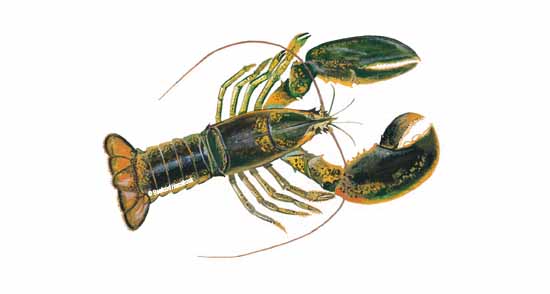Lobster, American
Published on
January 23, 2014

American lobsters have two powerful claws — a crusher and a ripper — which should be kept banded to prevent injury to other lobsters or the cook. The meatiest part of the animal is the tail, though claws, knuckles, body and small walking legs offer meat, too. American lobsters are found in the North Atlantic from Labrador to North Carolina. Major producers are Atlantic Canada, Maine and Massachusetts, in that order. The lobsters are harvested from depths of 15 to 1,000 feet in rectangular, wire-mesh traps. Market sizes range from “chickens” (1 to 1 1/8 pound) to jumbos (over 3 1/2 pounds). A pound of meat can be extracted from four to six lobsters weighing 1 to 1 1/4 pounds. A lobster sheds its shell annually, revealing a soft new one underneath. Though the newly molted lobster is much larger, its meat is watery and flaccid. New-shells offer lower meat yields than hardshells (30 to 45 percent vs. 55 percent).
Homarus americanus
Lobster
American, Maine or Canadian lobster
Homard Américain
Amerikanischer Hummer
Astice Americano
Ise ebi
Bogavante Americano
American lobsters have two powerful claws — a crusher and a ripper — which should be kept banded to prevent injury to other lobsters or the cook. The meatiest part of the animal is the tail, though claws, knuckles, body and small walking legs offer meat, too. American lobsters are found in the North Atlantic from Labrador to North Carolina. Major producers are Atlantic Canada, Maine and Massachusetts, in that order. The lobsters are harvested from depths of 15 to 1,000 feet in rectangular, wire-mesh traps. Market sizes range from “chickens” (1 to 1 1/8 pound) to jumbos (over 3 1/2 pounds). A pound of meat can be extracted from four to six lobsters weighing 1 to 1 1/4 pounds. A lobster sheds its shell annually, revealing a soft new one underneath. Though the newly molted lobster is much larger, its meat is watery and flaccid. New-shells offer lower meat yields than hardshells (30 to 45 percent vs. 55 percent).
Lobster meat is mild and sweet in flavor. The texture is firm and somewhat fibrous; tail meat is firmer than that in the claws. Live lobsters range in color from brownish rust to bright blue to greenish brown. All lobster shells turn bright red when cooked. The meat is white with red tinges. Live lobsters should be active, and their tails should curl, not dangle, beneath them. Cook weakened lobsters immediately; discard dead ones.Consumers are advised not to eat the tomalley, the light-green substance found in the lobster. This is the liver and pancreas, which accumulates contaminants from the creature’s environment.
| Calories: | 90 |
| Fat Calories: | 8.1 |
| Total Fat: | 0.9 g |
| Saturated Fat: | 0.2 g |
| Cholesterol: | 95 mg |
| Sodium: | 296 mg |
| Protein: | 19 g |
| Omega 3: | 0 g |
Opinions vary on how best to cook lobster. Some say steaming is best because it is gentle heat, which will not toughen the meat. Others say boiling seals the flavor into the lobster. Baking is another option, but the lobster should be quickly boiled or steamed beforehand. A cooking rule of thumb for 1 1/4-pound lobsters is 12 to 15 minutes; for larger lobsters, about 17 minutes.
Spiny lobster, Crawfish, Crab
- Bake
- Boil
- Broil
- Fry
- Grill
- Pate
- Poach
- Saute
- Smoke
- Steam
Live
Fresh: Cooked claw (knuckle meat), Picked meat
Frozen: Whole-cooked, Cooked claw (knuckle meat), Tails, Tail medallions, Claws
Value-added: Canned meat, Stuffed tails, Frozen entrées
Canada, United States





